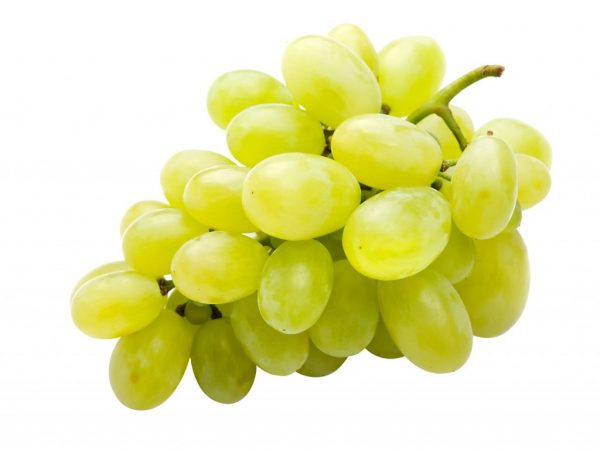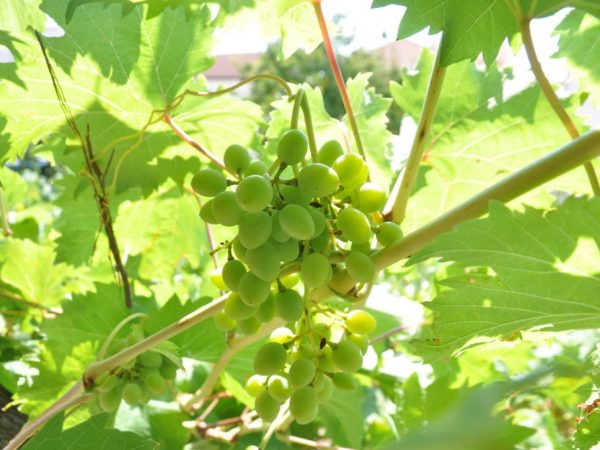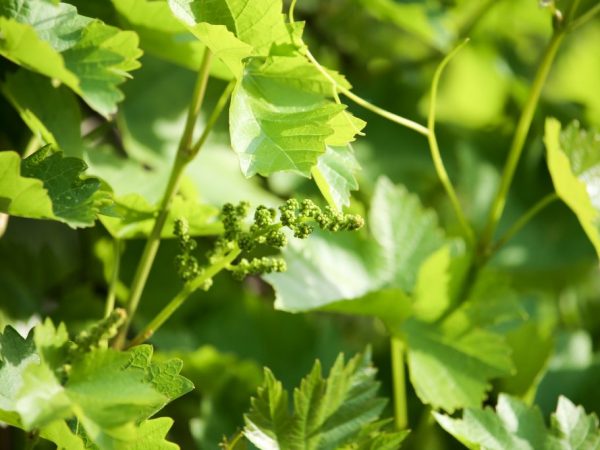Zarnitsa grapes
The Zarnitsa grape is one of the best varieties to grow. The variety is hybrid. It was bred by combining Radiant raisins and White grapes. The variety belongs to the white dining family.

Zarnitsa grapes
Characteristics of the variety
The Zarnitsa grape variety has a high rate of early maturity. The berries ripen in 90-110 days from the vegetation stage. The variety is characterized by a high yield.
Main advantages:
- The fruits can stay on the branches for a long time without crumbling and spoiling.
- Frost resistance is high. Zarnitsa grapes can withstand temperatures down to -23 ° C.
Description of appearance
The bushes have a similar description with other similar varieties obtained by crossing raisins. The grapes grow to a height of 1.9-2.3 m.
The variety has large sheets of bright green color. Due to the strong and developed roots of the Zarnitsa grape, the bushes have few stepson shoots, which has a good effect on the rate of development of the bunches.
The bunches are large - 25-30 cm. The berry mass reaches 11-13 g. The bunches are not too loose, have an elongated shape, and their average weight is 550 g.
The taste is sweet with a slight sourness. There is also a slight nutmeg flavor. The pulp has a large amount of juice, covered with a dense skin. The fruits themselves are elastic and dense, which allows them to be transported without the risk of cracking.
Chemical indicators of fruits:
- acidity - 6.3-6.8 g / l;
- sugar content - 18.2%.
Growing technique
Planting Zarnitsa grapes is no different from planting similar hybrid varieties of raisins. The plant is not whimsical to growing conditions and does not require specific care.
Grapes grow best in loose soil with an average moisture content. It is better to plant seedlings at the end of March with constant daytime warmth.
Landing in the ground
The sequence of planting seedlings in the soil:
- Choose a place. It must be protected from the wind and have access to sunlight.
- Dig a hole (about 50x50 cm). It is better to make a depression of 50-60 cm.
- Create a bottom layer. They put the soil mixture, water and mineral dressings.
- Disembarkation. The seedling is placed in a hole, and covered with simple soil on top.
2-3 cuttings are planted in the recess at the same time. This increases the germination rate. The distance between the pits is 1.5-2 m.
Plant care

Plants are easy to care for
Seedling care procedures differ depending on the season:
- Spring. The layer of winter shelter is removed and the rest of the melt water after the snow is removed from the ground.
- Summer. Garter and pinch the branches, and inspect the plant for damage.
- Fall. After the end of the collection of berries and the fall of the leaves, cut off all excess branches and prepare the plant for winter. At the end of November, before the first snow, the bush is covered with a layer of earth and branches.
- Winter. Make sure that the grapes are not heavily covered with snow.
Top dressing
The following mineral compositions are used as top dressing for Zarnitsa grapes:
- nitrogen;
- phosphoric;
- potash;
Additionally, the soil is fertilized with such organic components:
- peat;
- chicken droppings;
- ash;
- fresh manure.
The initial fertilizer is added when planting seedlings. It consists of a complex of all minerals in one proportion. The second is carried out 16 days before flowering. It consists of a solution of poultry droppings in water with the addition of phosphorus preparations. The third dressing is applied when ripe fruits appear.
Moisture introduction
According to the description, Zarnitsa grapes require regular watering:
- when planting;
- 7-10 days after cutting the bush;
- when processes appear with a height of 30-32 cm;
- 5-8 days before the flowering period;
- when large bunches appear;
- a week before harvesting the fruits;
- before winter.
Diseases and harmful insects
Treatment of diseases
Possible diseases:
- mildew;
- gray rot;
- anthracnose;
- dark spotting;
- powdery mildew.
To eliminate the fungus on grapes, direct acting fungicides are used. They are used both for eliminating the disease and for prophylaxis.

For prevention, spraying with fungicides should be carried out.
Preparations against mold and fungi:
- Tannos;
- Extra acrobat;
- Ridomidoll;
- Topaz;
- Strobin;
- Tioviton.
If rotten formations are found on the shoots, they must be cut off. The cut sites are treated with a growth biostimulant. Also for diseases use a solution of copper chloride and Bordeaux liquid
Elimination of harmful insects
Pests:
- grape aphid
- leaf roll;
- cicada;
- mites and spiders;
- phylloxera;
- pillowcase;
- goldfish.
Chemical and natural fumigants are used against harmful insects. They also use drugs such as Aktelik, Confido and Zalon. To get rid of caterpillars, grapes must be sprayed with a solution of nitrapheon or benzophosphate in water.
The processing of branches by Aktar eliminates cicadas. For the treatment of ticks, Neoron, Fufan and Omayt are used. When infected with goldfish, treatment with Karbofos is performed
Prophylaxis
To prevent the appearance of infections and diseases, it is required to conduct a periodic inspection of the bushes. Also, the spread of infections is stopped by the timely introduction of organic fertilizers and mineral fertilizers.
From folk remedies, a tincture of dill, chamomile, parsley or dry onion peel is used. Also, diseases are prevented by the introduction of wood ash into the soil.
Conclusion
The Zarnitsa grape is a good variety for growing on your own plot. It makes delicious white wine and juice.
When buying cuttings, you need to carefully examine them and choose high-quality ones. They should be free of signs of fungus, rot and physical damage.

